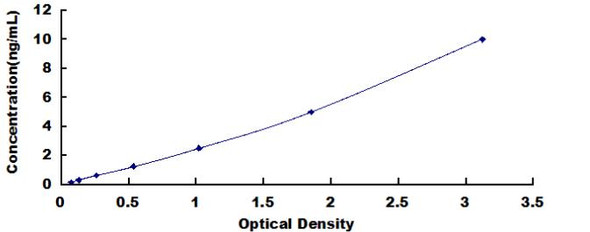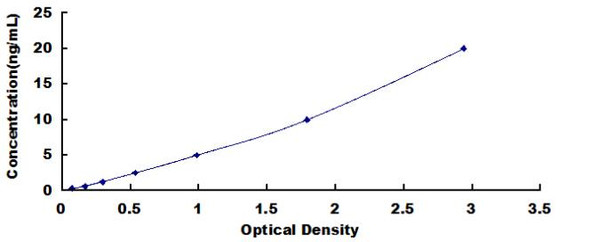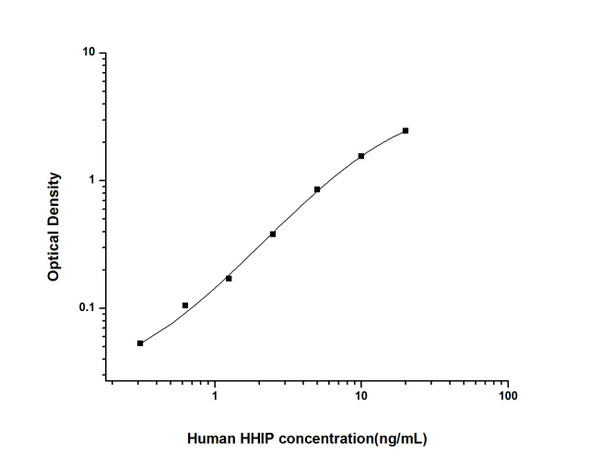Mouse Cell Signalling ELISA Kits 2
Mouse HHIP (Hedgehog Interacting Protein) CLIA Kit (MOES00332)
- SKU:
- MOES00332
- Product Type:
- ELISA Kit
- ELISA Type:
- CLIA Kit
- Size:
- 96 Assays
- Sensitivity:
- 18.75pg/mL
- Range:
- 31.25-2000pg/mL
- ELISA Type:
- Sandwich
- Reactivity:
- Mouse
- Sample Type:
- Serum, plasma and other biological fluids
Description
| Assay type: | Sandwich |
| Format: | 96T |
| Assay time: | 4.5h |
| Reactivity: | Mouse |
| Detection method: | Chemiluminescence |
| Detection range: | 31.25-2000 pg/mL |
| Sensitivity: | 18.75 pg/mL |
| Sample volume: | 100µL |
| Sample type: | Serum, plasma and other biological fluids |
| Repeatability: | CV < 15% |
| Specificity: | This kit recognizes Mouse HHIP in samples. No significant cross-reactivity or interference between Mouse HHIP and analogues was observed. |
This kit uses Sandwich-CLIA as the method. The micro CLIA plate provided in this kit has been pre-coated with an antibody specific to Mouse HHIP. Standards or samples are added to the appropriate micro CLIA plate wells and combined with the specific antibody. Then a biotinylated detection antibody specific for Mouse HHIP and Avidin-Horseradish Peroxidase (HRP) conjugate are added to each micro plate well successively and incubated. Free components are washed away. The substrate solution is added to each well. Only those wells that contain Mouse HHIP, biotinylated detection antibody and Avidin-HRP conjugate will appear fluorescence. The Relative light unit (RLU) value is measured spectrophotometrically by the Chemiluminescence immunoassay analyzer. The RLU value is positively associated with the concentration of Mouse HHIP. The concentration of Mouse HHIP in the samples can be calculated by comparing the RLU of the samples to the standard curve.
| UniProt Protein Function: | Function: Modulates hedgehog signaling in several cell types, including brain and lung through direct interaction with members of the hedgehog family. Soluble forms inhibit Shh-induced differentiation in the fibroblast cell line C3H/10T1/2. |
| UniProt Protein Details: | Subunit structure: Interacts with all three hedgehog family members, SHH, IHH and DHH. Ref. 1 Subcellular location: Cell membrane; Peripheral membrane protein. Secreted. Note: The last 22 C-terminal amino acids may participate in cell membrane attachment. Ref. 1 Tissue specificity: In the adult brain, high expression found in the ventral cochlear nucleus, medial habenula, indusium griseum and tenia tecta. Some expression also in the caudate putamen, the nucleus accumbens, the ventral pallidum and in the superficial layers of the surerior colliculus. Ref. 4 Developmental stage: First detected at 8. 75 dpc, in the ventral midline of the neural tube and in the ventral medial somites. At 10. 5 dpc, expression in the notochord is maintained in the caudal region. Expression is lost in the floor plate, but is retained in the ventral half of the neural tube and in the sclerotome of the adjacent somites. In the midbrain, expression confined to two lateral stripes adjacent to the floor plate. Also expressed in the gut mesenchyme along the length of the gastro-intestinal tract and in the mesenchyme of the posterior half of the limb. Expressed in the underlying mesenchyme of the epithelium of a number of tissues including lung, gut and whisker. Also expressed in the perichondrium and in the androgen-producing interstitial somatic cells of the developing testis. Ref. 1 Domain: A flexible loop interacts with the SHH zinc binding site and contributes to zinc binding By similarity. Sequence similarities: Belongs to the HHIP family. Contains 2 EGF-like domains. |
| UniProt Code: | Q7TN16 |
| NCBI GenInfo Identifier: | 160358774 |
| NCBI Gene ID: | 15245 |
| NCBI Accession: | NP_064655. 4 |
| UniProt Secondary Accession: | Q7TN16,Q8C0B0, Q9WU59, |
| UniProt Related Accession: | Q7TN16 |
| Molecular Weight: | 78,513 Da |
| NCBI Full Name: | hedgehog-interacting protein |
| NCBI Synonym Full Names: | Hedgehog-interacting protein |
| NCBI Official Symbol: | Hhip |
| NCBI Official Synonym Symbols: | Hhip1 |
| NCBI Protein Information: | hedgehog-interacting protein |
| UniProt Protein Name: | Hedgehog-interacting protein |
| Protein Family: | HSP-interacting protein |
| UniProt Gene Name: | Hhip |
| UniProt Entry Name: | HHIP_MOUSE |
As the RLU values of the standard curve may vary according to the conditions of the actual assay performance (e. g. operator, pipetting technique, washing technique or temperature effects), the operator should establish a standard curve for each test. Typical standard curve and data is provided below for reference only.
| Concentration (pg/mL) | RLU | Average | Corrected |
| 2000 | 51226 60216 | 55721 | 55693 |
| 1000 | 22297 25651 | 23974 | 23946 |
| 500 | 11185 10879 | 11032 | 11004 |
| 250 | 5247 5341 | 5294 | 5266 |
| 125 | 2804 2412 | 2608 | 2580 |
| 62.5 | 1404 1218 | 1311 | 1283 |
| 31.25 | 638 710 | 674 | 646 |
| 0 | 27 29 | 28 | -- |
Precision
Intra-assay Precision (Precision within an assay): 3 samples with low, mid range and high level Mouse HHIP were tested 20 times on one plate, respectively.
Inter-assay Precision (Precision between assays): 3 samples with low, mid range and high level Mouse HHIP were tested on 3 different plates, 20 replicates in each plate.
| Intra-assay Precision | Inter-assay Precision | |||||
| Sample | 1 | 2 | 3 | 1 | 2 | 3 |
| n | 20 | 20 | 20 | 20 | 20 | 20 |
| Mean (pg/mL) | 95.57 | 306.95 | 761.35 | 93.30 | 307.50 | 787.51 |
| Standard deviation | 11.98 | 32.57 | 68.45 | 10.48 | 28.23 | 64.42 |
| C V (%) | 12.54 | 10.61 | 8.99 | 11.23 | 9.18 | 8.18 |
Recovery
The recovery of Mouse HHIP spiked at three different levels in samples throughout the range of the assay was evaluated in various matrices.
| Sample Type | Range (%) | Average Recovery (%) |
| Serum (n=5) | 84-100 | 91 |
| EDTA plasma (n=5) | 86-98 | 93 |
| Cell culture media (n=5) | 89-100 | 94 |
Linearity
Samples were spiked with high concentrations of Mouse HHIP and diluted with Reference Standard & Sample Diluent to produce samples with values within the range of the assay.
| Serum (n=5) | EDTA plasma (n=5) | Cell culture media (n=5) | ||
| 1:2 | Range (%) | 86-99 | 94-109 | 88-99 |
| Average (%) | 93 | 101 | 93 | |
| 1:4 | Range (%) | 98-111 | 90-105 | 91-106 |
| Average (%) | 104 | 97 | 99 | |
| 1:8 | Range (%) | 90-103 | 93-108 | 90-105 |
| Average (%) | 96 | 99 | 98 | |
| 1:16 | Range (%) | 84-100 | 95-108 | 101-115 |
| Average (%) | 91 | 102 | 107 |
An unopened kit can be stored at 4°C for 1 month. If the kit is not used within 1 month, store the items separately according to the following conditions once the kit is received.
| Item | Specifications | Storage |
| Micro CLIA Plate(Dismountable) | 8 wells ×12 strips | -20°C, 6 months |
| Reference Standard | 2 vials | |
| Concentrated Biotinylated Detection Ab (100×) | 1 vial, 120 µL | |
| Concentrated HRP Conjugate (100×) | 1 vial, 120 µL | -20°C(shading light), 6 months |
| Reference Standard & Sample Diluent | 1 vial, 20 mL | 4°C, 6 months |
| Biotinylated Detection Ab Diluent | 1 vial, 14 mL | |
| HRP Conjugate Diluent | 1 vial, 14 mL | |
| Concentrated Wash Buffer (25×) | 1 vial, 30 mL | |
| Substrate Reagent A | 1 vial, 5 mL | 4°C (shading light) |
| Substrate Reagent B | 1 vial, 5 mL | 4°C (shading light) |
| Plate Sealer | 5 pieces | |
| Product Description | 1 copy | |
| Certificate of Analysis | 1 copy |
- Set standard, test sample and control (zero) wells on the pre-coated plate and record theirpositions. It is recommended to measure each standard and sample in duplicate. Note: addall solutions to the bottom of the plate wells while avoiding contact with the well walls. Ensuresolutions do not foam when adding to the wells.
- Aliquot 100µl of standard solutions into the standard wells.
- Add 100µl of Sample / Standard dilution buffer into the control (zero) well.
- Add 100µl of properly diluted sample (serum, plasma, tissue homogenates and otherbiological fluids. ) into test sample wells.
- Cover the plate with the sealer provided in the kit and incubate for 90 min at 37°C.
- Aspirate the liquid from each well, do not wash. Immediately add 100µL of BiotinylatedDetection Ab working solution to each well. Cover the plate with a plate seal and gently mix. Incubate for 1 hour at 37°C.
- Aspirate or decant the solution from the plate and add 350µL of wash buffer to each welland incubate for 1-2 minutes at room temperature. Aspirate the solution from each well andclap the plate on absorbent filter paper to dry. Repeat this process 3 times. Note: a microplatewasher can be used in this step and other wash steps.
- Add 100µL of HRP Conjugate working solution to each well. Cover with a plate seal andincubate for 30 min at 37°C.
- Aspirate or decant the solution from each well. Repeat the wash process for five times asconducted in step 7.
- Add 100µL of Substrate mixture solution to each well. Cover with a new plate seal andincubate for no more than 5 min at 37°C. Protect the plate from light.
- Determine the RLU value of each well immediately.






